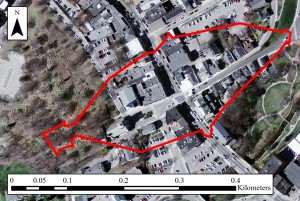Good question. Luckily, historical archaeologists have a lot of resources to help us out. Long before the team opened excavations on the perimeter of Burial Hill, we collected old maps and conducted geophysical surveys to help us determine the precise coordinates of each excavation unit.
The historical record suggests that the first Plymouth Colony fort was located at the top of Burial Hill and the palisade walls ran down the slope of the hill. According to early accounts, the walls of the fort were diamond shaped, and the main East/West street ran along modern-day Leyden St. in downtown Plymouth. Since archaeological sites are often disturbed by construction from later periods, we used historic maps provided by Plimouth Plantation to find areas with the best potential for the preservation of 17th-century material.
The eastern perimeter of Burial Hill has two qualities which make it a good place to start looking. First, the modern landscape is a larger open area, making it a good location for a geophysical survey. Second, according to old maps, we know there were buildings running along School St. in the 19th and early 20th centuries and probably earlier. If these buildings were built on top of older deposits, they may have preserved 17th-century material for us to find.
Brian Damiata, the geophysicist on the team, analyzed data from the Ground Penetrating Radar (GPR) survey conducted in 2013 to help us determine where to place our excavation units. Our first priority is to not disturb any potentially unmarked graves on Burial Hill. Luckily, GPR can identify unmarked graves so that we can avoid them. The GPR survey also showed anomalies which appeared to be the foundations of 18th and 19th century buildings along school street a safe distance away from the graves on Burial Hill.

Map overlay of previous structures from historic maps, aerial photography, and projected excavation units.
So far, the historical data and geophysical data have worked hand in hand to help us figure out where to dig next. Now that we have opened up a few excavation units, archaeological data can help us make even more informed decisions.

